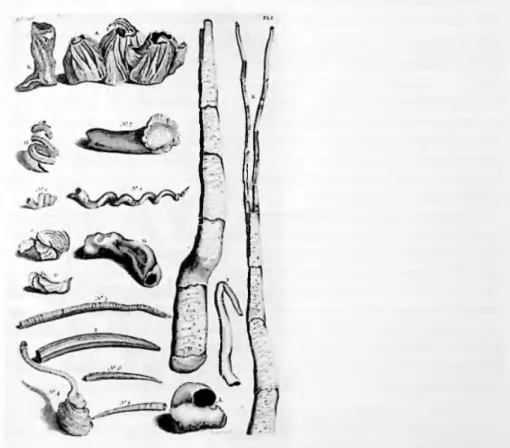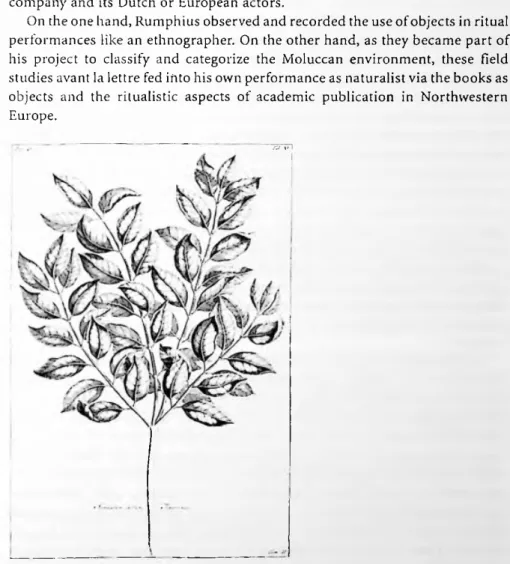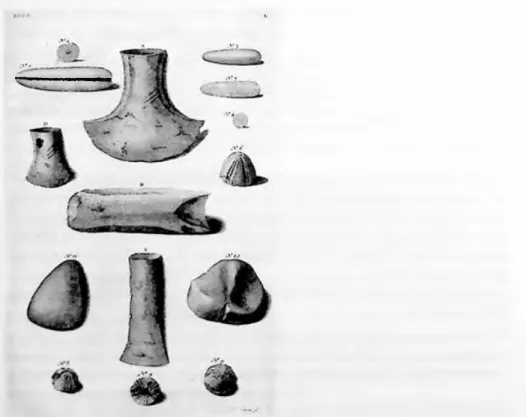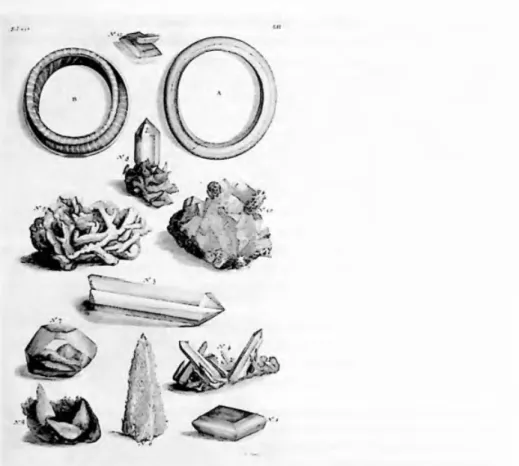Esther Helena Arens / Maria-Theresia Leuker
Ritual and Ceremony in Rumphius*Amboinsche Rariteitkamer and Kruid-boek
The connection between ritual, material, and space
One of the secular rituals of European t ravelers in Southeast-Asia was publishing a book after their return, oftentimes telling sensational stories to satisfy demand, for example “The Six Voyages of J. Baptista Tavernier”.1 The author related events that had taken place on Java, and the Dutch version of the book included not only the depiction of a kanjar, a large double-edge dagger, but also one of how an angry fakir, just returned from the hadj, killed 13 Dutch sailors with such a dagger.2 Artifacts and religion play an important role in these eyewitness reports, but they are often confined to the spectacular as in Tavernier and to general practical information for the public as in Valentijn’s Oud eti Nieuw Oost-Indien.3 This is different in the books on the flora and fauna of Ambon by G.E. Rumphius:
Because the merchant and naturalist worked on the island for decades, he was embedded in daily life between the beach, Fort Victoria of Kota Ambon, and the mountain gardens on the island. To make the link between cultural expressions and commercial possibilities in his texts, he documented religious rituals and ceremonies in the different communities present in the Moluccas.^ Therefore, many entries go beyond descriptions of taxonomy and materia medica to include descriptions of objects - how these were fashioned from the specific organism in question, and in which contexts they were used.
1 De zes reizen van de I leer J. Baptist T
avernier. Tweede Deel. Door J.H. G
lazemakervertaalt.
Met veel kopere Platen verciert. Amsterdam 1682.
2 Cf. ibid., pp. '100-01 and 402-03.
3 Cf. Francois V
alentijn, Oud en Nieuw Oost-Indien, Dordrecht 1724-1726.
4 Cf. Romain B
ertrand, The Interplay of Identities in Contacts Between Europe and Insulindia
in the 16th and 17th Centuries, in: Concilium 1 (2017), pp. 41-52 on the Asian perspective on
the encounters and confrontations with Europeans; and Keebet von B
enda-B
eckmann,
Ambon, a Spicy Hub. Connectivity at the Fringe of the Indian Ocean, in: Connectivity in
Motion. Island Hubs in the Indian Ocean World (Palgrave Series in Indian Ocean World
Studies), ed. Edward A. A
lpers, Burkhard S
chnepel, Cham 2018, pp. 421-46 on the colonial
legacy of the spice trade.
In the second half of the seventeenth century, the Dutch East India company had established its gewest or district of Ambon to control the lucrative trade in cloves and nutmeg between Southeast Asia and Northern Europe.' At the same time, the company was a player in the interregional so-called “country trade” as well, negotiating other commodities than spices and access to markets with other actors like the Chinese established on the Indonesian islands, Bugis from Sula
wesi, or Arab merchants.6 In the Atnbonese Herbal, Rumphius mentioned many different groups - according to politics like “our nation” (onze natie) or the
“Malay nations” (maleytsche tiatien), to religion like Christians, heathens, and Muslims, or to geographic origin, like Macassaren or Javanen.' Especially if these groups were settled in communities on Ambon under Dutch control, Rumphius referenced their ritual objects not only in spaces of public interaction, but also in the more confined place of the household. Especially the interface between shared space and personal household could be regulated by the company, for example in (by-) laws on clothing, travel, or business8, and information on collectives could feed into this process.
In Rumphius’ representation, these objects sometimes shifted between the European order of artificialia and naturalia9, depending on their perceived place of origin and their ascribed value - i.e. within the described communities themselves, and in relation to the Dutch.
5 Cf. the map and commentary “Ontwerphinge van Amboyna (1623)”, in: Grote Atlas van de Verenigde Oost-Indische Compagnie. Part III Indische Archipel en Oceanic, ed. Arend de R oever , Bea B rommer , Voorburg 2008, p. 267.
6 Cf. Heather S utherland , On the Edge of Asia. Maritime Trade in East Indonesia, Early Seventeenth to Mid-twentieth Century, in: Commodities, Ports and Asian Maritime Trade Since 1750, ed. Ulbe B osma , Anthony W ebster , London, New York: Palgrave Macmillan 2015, pp. 59-78 on trade routes; and Jurgen N agel , Abenteuer Fernhandel. Die Ostindien- kompanien, 2nd edition with updated bibliography, Darmstadt 2011, pp. 154-59 on compe
titors.
7 Cf. Book VII Containing Potherbs Used For Food, Medicine, and Sport, in: Georgius Everhardus R umphius , The Ambonese Herbal, translated, annotated, and with an introduction by Eric Montague B eekman , 6 vols. New Haven/London: Yale University Press/National Tropical Botanical Garden 2011, here vol. 4. Dutch original: Georgius Everhardus R umphius , Het Amboinsche Kruid-boek: Dat is, Beschryving van de meest bekende Boomen, Heesters, Kruiden, Land- en Water-Planten, die men in Amboina, en de omleggende eylanden vind, Na haare gedaante, verscheide benamingen, aanqueking, en gebruik | — J, 6 vols., Amsterdam:
Francois Changuion, Jan Catuffe, Hermanus Uylwerf; Den Haag: Pieter Gosse, Jean Neaulme, Adriaan Moetjens, Antony van Dole; Utrecht: Steven Neaulme, 1741-1750.
8 Cf. the collection of sources in J.A. van der C hijs , Nederlandsch-lndisch Plakkatboek, 1602-1811. Tweede Deel 1642-1677, Batavia/Den Haag 1886.
9 Cf. Horst B redekamp , Antikensehnsucht und Maschinenglauben. Die Geschichtc der
Kunstkammer und die Zukunft der Kunstgeschichte, Berlin 4th edition 2012, pp. 38-39, on the
order of Curiosity Cabinets.
Ritual and Ceremony in Rumphius' Amboinsche Rarileitkamer and Kruid-boek 373
In the sixteenth and seventeenth centuries a nation’s level of civility was determined by examining religion, morality, type of government, material culture, manner of making war, and cultivation and preparation of food, among other things. The distinction between Christian and non-Christian was, however, the real litmus test for dis
tinguishing ‘us’ versus ‘them’ for most Europeans.10
Even though these parts of Rumphius’ early modern texts can be characterized as ethnographic, they were (and are) still contained within the confines of zoo
logical and botanical book publications. From a material culture perspective on rituals and ceremony, then, the relation between the taxonomical categories of the natural historian and the classifications of the historian/ethnographer comes to the foreground." Which kind of rituals did Rumphius record? While the books were edited by Joan Burman in contact with Linnaeus’ taxonomical system from the 1730s onwards, Rumphius wrote or dictated his texts about a hundred years before the homo sapiens was named in the 1766 edition of System a na
turae.,12 How did Rumphius describe and order the ritual objects he had en
countered? If “ritual practices are themselves the very production and nego
tiation of power relations”13, might the power asymmetry between him and the people he studied have changed rituals and spaces?
The description of rituals in the context of knowledge production in natural history
Georg Everhard Rumpf or Rumphius was born in 1627 in a small town in the German territory of Hassia. He grew up in a Calvinist environment and attended the Gymnasium in Hanau. In 1653 he joined the Dutch East India Company and was stationed on Ambon in the Moluccas, first as a soldier and later as a civil servant. He stayed there until his death in 1702. Beside his administrative oc
cupation, in the course of which he advanced to the position of koopman, merchant, he devoted himself to studying the local flora and fauna. He planted a garden and started collections of plants, shells, crustaceans and minerals. In the early 1660s he began to build a library containing the canonical literature about natural history of his time. His superiors supported his efforts. Rumphius had 10 Rebecca Parker B rienen , Visions of Savage Paradise. Albert Eckhout, Court Painter in
Colonial Dutch Brazil, Amsterdam 2006, p. SO.
11 Cf. Barbara S toli . berg -R ilinger , Rituale (Historische Einfuhrungen, 16), Frankfurt/New York 2013, pp. 17-43, on the “ritual turn” in the academic discipline of history in Germany, which does not explicitly touch on questions of colonial history.
12 Cf. Jakob T anner , Historische Anthropologie zur Einfuhrung, Hamburg 3rd unchanged edition 2017, pp. 37-38.
13 Catherine B ell , Ritual Theory, Ritual Practice. Paperback edition Oxford et al. 2009, p. 196.
not yet made much progress with the systematic documentation of the results of his research in texts and illustrations, when, in 1670, he went blind. The Dutch East India Company sent secretaries and draughtsmen to Ambon so that Rum- phius could concentrate completely on the continuation of his research. Rum- phius wrote in Dutch and reached a wide audience in the Netherlands and in South East Asia. All his texts were written or completed after 1670. Except for a few short texts, they did not appear in print during his lifetime, but were only published decades or even centuries after his death.
The Amboinsche Rariteitkamer or Ambonese Curiosity Cabinet, a description of shells, crustaceans and minerals of Ambon and its surroundings, was pub
lished in Amsterdam in 1705. The six volumes of the Amboinsche Kruid-boek followed between 1741 and 1745. These books and Rumphius’ correspondence, in as far as it has been passed down to us, convey an impression of the production of knowledge in a third space in between South East Asia and Europe as well as of the knowledge transfer between South East Asia and Europe. Rumphius was not the typical traveller visiting East India for a limited period, just passing through and returning to Europe after having collected his samples. He settled down on Ambon permanently, married a local woman, started a family and lived there for many decades until his death. He also acquired knowledge of the local languages and developed into a migrant who sometimes even possessed a ‘double vision’.
These circumstances not only allowed him to make precise observations of the natural environment but also granted him the possibility to become acquainted with and study the cultures of the region in which he lived. Many of his de
scriptions of rituals and ceremonies were not only based on observation but also on personal exchange with the actors performing them. Thus, in his descriptions of plants and animals, Rumphius did not confine himself to their appearance, names and habitat, but in many cases also detailed their ritual function and symbolic meaning in the context of local cultures. What do his descriptions reveal about his perspective on the rituals and their cultural context, as well as about his attitude towards their actors? Are his texts merely describing or are they also evaluating? In which way is the perspective implicit in the text con
cerning the described rituals influenced by the European and Christian back
ground of the author and his position in the colonial hierarchy?
In the section on the material culture of rituals and ceremony, the qualitative case studies are drawn from entries on shells in Book II and gold, glass, and fossilized coral in Book III of the Ambonese Curiosity Cabinet, as well as on two species of trees from Book II Containing the Aromatic Trees: Being Those That Have Aromatic Fruits, Barks or Redolent Wood in the Ambonese Herbal.
The texts discussed in the section on the medial representation of rituals and
ceremony come from the Ambonese History, whereas the entry on the Carina
indica is taken from the Ambonese Herbal. Entries on a shell can be found in
Ritual and Ceremony in Rumphius' Amboinsche Rariteitkamer and Kruid-boek 375
Book II of the Ambonese Curiosity Cabinet, while those on Ambonese quartz crystal, metal, thunder stones, bezoar stones and other concretions found in animals or plants are taken from book III of the same work.
Materials between prayer and sacrifice: Ritual objects and their colonial entanglements
In the above-mentioned illustrations by J. Baptista Tavernier, the ships in the background of the illustration on the amok incident signified European trade and colonialism. In the Ambonese Curiosity Cabinet, Rumphius made the same connection in the chapter about “How they falsify gold in these countries” which starts the third book “of the Minerals, Stones, And other rare things”.14 In this chapter, lie first drew an explicit connection between money and ritual, reaching deep into the Moluccan households:
But no matter there be little, everyone wants to have some of it in his house, for no family counts itself happy where this House God is not present, and this is the reason why the small amount, that one can find today, is thinned, stretched, beaten, and falsified, so that it will at least resemble gold.15
With the categorization of gold as a “House God”, he then drew an implicit distinction between these locals and the Protestant Christian worshipping in a plain Church without the baroque splendor of Catholicism. While he did men
tion the spiritual pursuit of “happiness” as the reason for the modification of the material, the emphasis on “falsification” devalued not only the gold in question, but also the rituals around it. The discussion of a specific form of craftsmanship finally fed into the perception of local people as potentially deceptive trade partners - especially if Rumphius followed mercantilistic thought and consid
ered coins made from precious metal served to conserve the value of work.16 This interpretation is supported by a passage on iron where he wrote about the
14 Georgius Everhardus R umphius , The Ambonese Curiosity Cabinet. Translated, edited, an
notated, and with an introduction by Eric Montague B eekman , New Haven: Yale University Press 1999, p. 231 f. Dutch original: Georgius Everhardus R umphius , D’Amboinsche Rari
teitkamer, Behelzende eene Beschryvinge van allerhande zoo weeke als hardeSchaalvisschen, te wecten raare Krabben, Kreeften, en diergelyke Zeedieren, als mede allerhande Hoorntjes en Schulpen, die men in d’Amboinsche Zee vindt: Daar beneven zommige Mineraalen, Gesteenten, en soorten van Aarde, die in d’Amboinsche, en zommige omleggende Eilanden gevonden worden, Amsterdam: Francois Halma 1705.
15 R umphius , Ambonese Curiosity Cabinet (n. 14), p. 231.
16 Cf. Wolfgang S ciiivelbusch , Das verzehrende Leben der Dinge. Versuch iiber die Kon-
sumtion, Frankfurt/Main 2016, p. 114.
ignorance of the Natives, who do not know how to extract it from various iron stones.'7
With plants, on the other hand, the knowledge on derivatives that could be extracted from leaves, fruits, or seeds was much more detailed on the side of the local population. Throughout the Ambonese Herbal, the entries’ last section on
“use” or “uses and powers” included information on plants for food, materia medica, packaging and building materials. Sometimes Rumphius had keenly observed embodiments of rituals while researching plants and recorded the materialization of prayer in seeds. In the case of The Rarak or the Soap-Balls Treel>> (today’s Sapindus saponaria, in English soapberry or washnut), the bo
tanical categorisation led to the use of the seeds as washing detergent and then to the prayers of imams: The black seeds remain whole in washing and are thrown away or given to Moorish Priests, who make Paternosters from them, for if they are turned and polished they are as beautifully black as Ebony, but much lighter [...].19 Similarly to the text on gold, the material only resembled a valuable commodity on the outside. While Rumphius employed rhetorical devices to stress blackness and therefore otherness here, he included the Latin term pa
ternoster for rosary that compared prayer beads to a Catholic practice as well.
Put into context with the anti-Catholic passages in his Ambonese History10, this functioned not as an endorsement, but as interpretative help for his Dutch/
European audience.
Similarly, in the Curiosity Cabinet, Rumphius drew a line from Chinese altars to the reveration of Christian saints in the entry on the Conchae Univalviae with the third part reading: III. Balani, Acorns, Weals, in Malay, Gindi laut, and opening Tulips, have the shape of a burst tumor, they grow together in bunches [...] The Chinese take the biggest clumps, place them before their House gods, and put small candles in them, like a candelabra [...].2] In the accompanying illus
tration, these Gindi laut (today’s Balanidae family of sessile barnacles") can be seen in the upper left-hand corner as part of a collection of shells ordered on paper, two small feather-like tentacles alluding to the living organism. In the second book of the Curiosity Cabinet, there are no depictions of artificialia, so that the image of objects and scenes is formed in the mind of the reader, perhaps on the basis of previous studies. Comments on Chinese rituals and habits seem to be more neutral throughout all of Rumphius’ books than those on other eth-
17 R
umphius, Ambonese Curiosity Cabinet (n. 14), p. 238.
18 R
umphius, Ambonese Herbal (n. 7), vol. 2 = Book II, chapter 51.
19 Ibid., vol. 2, pp. 199-200.
20 R
umphius, De Ambonse Historic (see below n. 34).
21 R
umphius, Ambonese Curiosity Cabinet (n. 14), pp. 174-76.
22 Cf. entry “Balanidae Leach, 1817” in World Register of Marine Species (WoRMS) at mari-
nespecies.org, visited 17 April 2017.
Ritual and Ceremony in Rumphius' Amboinsche Rariteitkamer and Kruid-boek 377
nicities. As he had a common law wife of mixed Asian-European descent, it is possible that she acted as a mediator between Rumphius and the Chinese community around Fort Victoria in Kota Ambon, making the interaction more familiar and the ritual objects less threatening.23
Illustration I: Gindi lain from the Amboinsche Rariteitkamer, via the digitized version by the Gottinger Digitalisierungszentrum, https://gdz.sub.unigoettingen.de/id/PPN372428037, visited 17 April 2018.
On the other end of the spectrum, Rumphius portrayed the so-called mountain people living on the Western part of the neighboring island Seram as the un
known, and almost unconquerable, other.21 In different chapters of the Herbal, the Alphorese men appeared as the “wild” counterpart to the company soldiers in
23 Cf. Eric Montague B
eekman, Introduction, in: The Ambonese Herbal (n. 7), vol. 1, pp. 1-169, here pp. 64-65 on Rumphius’ wife and family.
24 Cf. Gerrit K
naap, Kruidnagelen en christenen. De Verenigde Oost-Indische Compagnie en
de bcvolking van Ambon 1654-1696, Leiden 2004, on Seram as the “periphery” of Ambon.
the military campaigns of the later seventeenth century. In the Curiosity Cabinet, Rumphius concentrated on a sacrifice ritual in the entry on Mamacur or Macur.25 [...] a thick, lumpish Armlet [...] made of glass [...] The Mamakur is [...] hung from a high beam in the nook of the house, because, as they say, it will not be locked down in any trunk: They take it down with the new moon, and sacrifice a chicken to it; [...] when they go on war or raids, they consult it, and want to foresee good or bad luck in it [...].26 Then Rumphius used a Greek compound noun to categorize the next step in the ritual as an ethnographer - “divination by means of a mirror” according to the editor2' probably drawing on the association of Greeks observing barbarians in the borderlands of ancient Europe. For the Alphorese, the sacral ritual of sacrifice formed the community and led to collective action. For Rumphius, the belief in the power of a glass armband separated not only the Alphorese, but also the Javanese who have become quite shrewd from dealing with Europeans for a long time16 from the producers of glass in the Dutch Fatherland and their secular outlook on demand and profit.29
Finally, the example of sandalwood (today’s Santalum album) shows how rituals lead to the categorisation of materials, especially when these are con
nected with smell, which is directly linked with the emotional center of the brain and the production of memories, as we know now.30 The illustration of the tree showed stem and leaves according to botanical norms and does not connect with coveted items crafted from the wood. Perusing the text the reader found out that for Rumphius, sandalwood was an object of intense scientific interest, as shown by his correspondence about the correct identification of the tree, as well as a luxurious household good serving a hygienic habit.31 For the Macassarese and Malay communities, though, it belonged solely to their funeral ceremonies:
The sawdust of Sandalwood, sewn into small pillows and placed among clothes, gives the same a good and lasting smell, but the Macassarese and Malay (I don’t know why) do not want to have the pure Sandalwood or the smell near their clothes, perhaps because they sprinkle their corpses with it, wherefore they call it a dead smell.*1
Here Rumphius almost casually contrasted the liminal ritual with individual consumption. It becomes clear that in his Ambonese books, the function of 25 R umphius , Ambonese Curiosity Cabinet (n. 14), pp. 276-78.
26 Ibid., pp. 276-77.
27 Ibid., pp. 276-77, and footnote 8 on p. 493.
28 Ibid., p. 276.
29 Ibid., p.277.
30 Cf. for example Lauren D avis and Lucienne T hys -S enocak , Heritage and Scent. Research and Exhibition of Istanbul’s Changing Smellscapes, in: International Journal of Heritage Studies 23 (2017), pp. 723-41.
31 R umphius , Ambonese Herbal (n. 7), vol. 2 = Book II, Chapter 16.
32 Ibid., vol. 2, p. 69.
Ritual and Ceremony in Rumphius’ Amboinsche Rariteitkamer and Kruid-boek 379 rituals as collective production of institutions33 time and again refers to religion on the side of the Asian communities and to the economy on the side of the company and its Dutch or European actors.
On the one hand, Rumphius observed and recorded the use of objects in ritual performances like an ethnographer. On the other hand, as they became part of his project to classify and categorize the Moluccan environment, these field studies avant la lettre fed into his own performance as naturalist via the books as objects and the ritualistic aspects of academic publication in Northwestern Europe.
.'VvI



